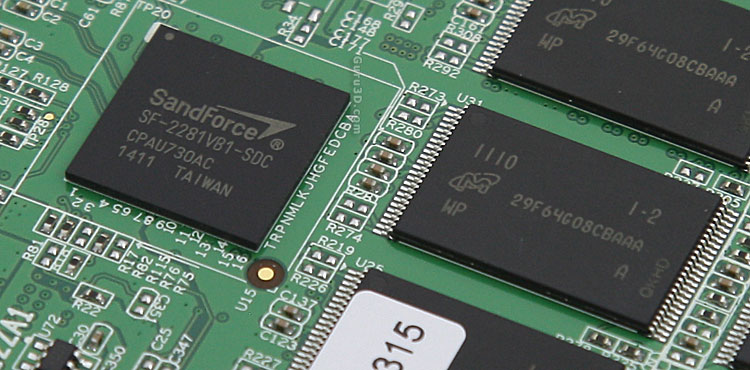SSD NAND FLASH partitions and the SF2281 controller
The SSD NAND FLASH partitions and the SF2281 controller
MLC vs. SLC
At the beginning, memory cells stored just a single bit of information. However, the charge on the floating gate can be controlled with some level of precision, allowing to store more information than just 0 and 1. Basing on such assumption the MLC (Multi Level Cell) memory came to exist. To distinguish them, the old memory type was called SLC - Single Level Cell.
The decision of choosing between SLC of MLC is driven by many factors as memory performance, number of target erase/program cycles and level of data reliability. The MLC memory endurance is significantly lower (around 10'000 erase/program cycles) comparing to SLC endurance (around 100'000 cycles).
So what about that new 25nm NAND lifespan ?
Personally I'm not at all excited about the new 25nm NAND FLASH memory, the overall lifespan of the ICs has been reduced from 10.000 towards 5,000 program/erase cycles. Rumors are that the numbers for consumer grade 25nm NAND flash memory (as used on the SSD tested today) are even lower at 3000 program/erase cycles.
But granted, as drastic as that sounds, it's all relative as this lifespan will very likely last longer than any mechanical HDD. Drive wearing protection will help you out greatly. With a normal filled SSD and very heavy writing/usage of say 10GB data each day 365 days a year you'd be looking at roughly 22 full SSD write cycles per year, out of the 3000 (worst case scenario) available. However, all calculations on this matter are debatable as usage differs and even things like how much free space you leave on your SSD can effect the drive.
Back to the Controller
SandForce, opposed to other controllers, enforces a trick as they can write to the FLASH memory less than the competition needs to, by using real time compression. The SF controllers store a representation of your data and not the actual data itself. It does that by using a partition of the available NAND flash memory. This is why on SandForce based drives you do not see an extra memory cache chip, which in fact saves on the bill of materials used for the SSDs.
Now we mentioned it already, but the SF-2281 series controller will support up to roughly 500MB/s sequential read and write speeds, that's 62.5MB/s per one of the available eight channels. Combined the bandwidth is just exceptional for a single non RAID drive.
SF-2281 controllers support TRIM. Deduct a few GB per partition for real-time data compression and then you have your SSD ready. But all that data needs to travel over an interface ... of course.

Corsair Force 3 PCB with 16 Micron NAND flash memory ICs (8 on each side).
